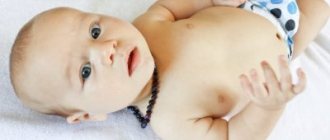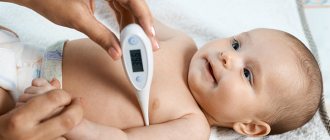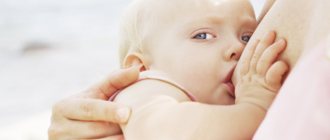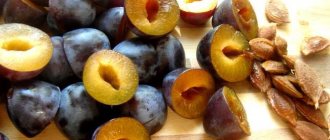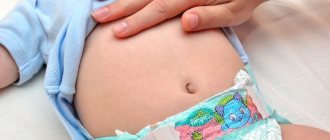Coughing occurs quite often in infants, but it is not always a sign of a condition that needs to be treated. This is a reflex reaction of the respiratory tract that occurs when any foreign bodies, including liquids, enter them. In babies, mucus, saliva, and milk often flow into the bronchi, and in order to clear them from the respiratory system, the child begins to cough. As soon as the irritant is eliminated, all the symptoms that alarm parents stop.
But a cough in a newborn and infant can also develop with a cold, an inflammatory process in the ENT organs, or bronchitis. And this is a problem that requires treatment.
Possible causes of cough in infants
Coughing in children in the first month of life, when the cough reflex is just developing, is rarely observed. The baby, especially if he is breastfed, is protected from viruses by maternal antibodies. So a cold is not often the cause of a cough in a newborn.
The following situations are more likely in a one-month-old baby:
- The baby starts coughing immediately after waking up, but is calm the rest of the time. Most likely, the reason for this is mucus that has accumulated during sleep and flowed into the respiratory tract.
- The child cried, then coughed. Explanation: tears and snot got into the throat, which caused irritation.
- Cough accompanies eating. The baby is probably in a hurry, swallows too much milk and begins to cough and choke.
- The cough is dry and occurs for no apparent reason. It is worth analyzing the environment in which the baby is located and the diet of the nursing mother for the presence of allergens (for artificial babies, pay attention to the mixture). Although in children in the first months of life, allergies manifest themselves mainly in the form of skin reactions, respiratory symptoms are also possible.
In the first 3 situations, the problem solves itself as soon as the baby clears his throat. When a cough occurs, it usually has to be treated with antihistamines. But the first priority is to identify and eliminate the allergen.
In an infant during the teething period, another cause of cough is added: increased salivation and flow of saliva into the throat. Parents of a newborn may confuse noisy breathing - stridor - with coughing and wheezing in the respiratory tract. It is due to the age-related characteristics of the structure of the larynx of children under one year old. Despite the frightening hoarse sound, this phenomenon is harmless, it does not need treatment, it goes away with age.
Types of cough and causes
Depending on the factors that cause cough, it is divided into physiological (needed to cleanse the respiratory tract) and pathological (appearing in many diseases).
Cough can be a symptom of the following diseases:
- ARVI
- Angina
- Laryngitis
- Pharyngitis
- Bronchitis
- Tracheitis
- Sinusitis
- Pneumonia
- Bronchial asthma
- Tuberculosis
- Whooping cough and other infections
- Allergy
- Helminth infection
If you pay attention to the coughing up of sputum, then there are such types of cough as dry (no sputum is produced) and wet (it is also called productive or wet). Normally, a newborn, infant 2 months or older can cough up sputum in the morning, as it accumulates during night sleep. Later during the day the baby will not have a cough, and the general condition will not change.
Having assessed the sound of a dry cough in an infant, you can define it as:
- Barking is a loud cough, reminiscent of a dog barking, usually occurring with laryngitis.
- Pulmonary – exhausting paroxysmal cough.
- Superficial – characteristic of pharyngitis.
What diseases can cause cough
One of the possible causes of cough in the first months of a child’s life may be a cold or ARVI. The baby runs the risk of becoming infected from others through airborne droplets, and weakened immunity and hypothermia contribute to the development of the disease. In children of one month of age, as well as older babies, up to a year, colds are manifested not only by cough. They are a stuffy nose, snot (usually quite liquid and transparent), lethargy.
Often, due to a cough and runny nose, sleep is disturbed, possibly. ARVI needs to be treated before it becomes complicated by more serious diseases. First of all, it is necessary to consult a doctor on the selection of medications that are appropriate for the baby’s age.
.
Cough is also accompanied by the following independent diseases and complications of a cold:
- laryngitis - cough is dry and hoarse, painful;
- sinusitis (most often sinusitis). Along with a cough that gets worse at night, its characteristic symptom is the discharge of purulent snot;
- whooping cough is a severe infectious disease accompanied by a prolonged intense cough that lasts for months;
- , can develop both in a month-old baby and at a later age. It manifests itself first as a dry, then wet cough.
Another cause of cough that is not related to illness, but requires immediate action, is aspiration.
In children, foreign bodies, liquid or solid, quite often enter the respiratory tract. In addition to a strong painful cough, suffocation often develops in such situations. It is not always possible for a child to clear his throat on his own and get rid of a foreign object. If your baby begins to cough and begins to choke, you should immediately consult a doctor.
Some children suffer from reflux esophagitis, a pathology of the digestive system.
In this case, the baby begins to cough due to the fact that acidic, irritating stomach contents have entered the esophagus and throat. This problem occurs mainly when the baby is lying down. It requires examination and treatment, but not at all the same as for colds.
Why does cough occur?
There are 2 large groups of reasons:
- Non-infectious
- Infectious
Non-infectious causes include:
- cough due to aspiration (inhalation) of a foreign object. One of the most dangerous conditions that can occur in a child. Simply put, a child can choke on a piece of food, a small part of a toy, or a non-food item (for example, a small wad of paper, etc.).
A short, dry cough in such a situation will be a signal to begin providing assistance. You need to act quickly, without waiting for the doctors to arrive. There is an option to grab the child under the ribs, performing the Heimlich maneuver, press on the root of the tongue, provoking the urge to vomit, and finally, simply turn the child over - all methods are good when you need to rid the baby of a foreign object in the respiratory tract. After breathing is restored, it will be necessary to show the child to specialists.
- allergic cough. In children of the first year of life, isolated respiratory allergies are extremely rare; in almost all cases it is associated with infection, however, a paroxysmal dry allergic cough can be triggered by inhalation of irritants, such as washing powders, detergents and disinfectants, etc. In such a situation, you need to quickly provide the child with access to fresh air and, if the attack continues, call an ambulance.
Infections associated with cough
Most viral and bacterial infections will cause your baby to cough to varying degrees of intensity.
Cough treatment
When a cough is caused by a disease in a newborn or infant, this disease must be treated, and the cough, if it is dry, should be tried to soften and make it moist. should correspond to the nature of the disease (antiviral for acute respiratory viral infections, antihistamines for an allergic reaction, antibiotics for a bacterial infection, for example, whooping cough). The pediatrician must determine the cause of the cough, the nature of the disease, and prescribe mild but effective therapy.
The cough itself can be treated with a number of pharmaceutical drugs:
- dry cough medicine. Designed specifically for children, suitable even for one month of age and even from the first days of life. The composition is plant-based, available in sachets, the contents of one sachet are calculated for 15 ml of water. Children under one year old should be given 15-20 drops per dose 3-4 times a day;
- Alteyka is another popular cough medicine for children, including infants. Also with plant extracts, but in syrup form. For preschoolers it must be diluted with water;
- Ambroxol, Lazolvan, Bromhexine and many other cough syrups should be given to children under 2 years of age in a minimum dosage. The lower age limit is not indicated in the instructions for these drugs; it is better to consult a pediatrician about what month of life you are allowed to give such drugs.
Non-drug treatment
In addition to using ready-made medications, you can treat your baby with prepared products.
- A gentle chamomile decoction will help a 1-2 month old baby. To prepare it, chamomile (1 tablespoon of flowers) needs to be poured with a glass of boiling water, and after a couple of hours, strain. Give the baby a teaspoon every hour, but if the cough is severe, this will not be enough;
- A decoction of coltsfoot and plantain leaves is indicated from 4 months. A tablespoon of raw materials mixed in equal proportions is poured with a glass of boiling water and left for 2 hours; it is better to use a thermos. This is an expectorant drug that may cause a gag reflex, in which case a dosage reduction is required. If there are no side effects, the baby can be given 2 tablespoons a quarter of an hour before meals;
- Licorice root helps a lot. The best effect is achieved when used together with marshmallow and elecampane roots. The components must be mixed in equal proportions. The infusion is prepared as follows: for half a liter of cold water you need a tablespoon of the mixture, the raw materials will have to be infused for 8 hours. 2-3 doses per day, 50 g at a time.
In addition to expectorants taken orally, warm compresses help eliminate coughing. But they can only treat a child at normal body temperature.
It is recommended to apply compresses not directly to the baby’s delicate skin, but to a diaper folded in several layers. A second diaper, wax paper or polyethylene is placed on top, and this entire structure is wrapped with a bandage or cloth.
You can also rub with badger, heated goat fat. It is best to treat the chest and legs. When making warm compresses and rubbing, you need to treat only the chest area, not the back. It is also important to exclude exposure to the heart area.
Small children do not know how to do inhalations, but you can saturate the air with healing vapors by pouring hot water with eucalyptus tincture into the bath. Then you just need to go into the room with the baby in your arms and stay there for about 10 minutes. It is better to bring him into the bathroom naked, and after the procedure, wipe him dry and wrap him up.
Can chamomile be used in the treatment of infants?
This medicinal plant is often used before the age of one year, as it has an anti-inflammatory and antimicrobial effect. If you brewed chamomile for a baby for the first time, give this herbal remedy a few drops to check the reaction of the baby’s body.
To prepare the decoction, take a tablespoon of dried flowers and a glass of boiled water, cover the container with a lid, and strain after 10 minutes. It is recommended to give this chamomile tea three times a day, half an hour after feeding, in an amount of up to 30 ml for children in the first months of life.
Chamomile can also be used for inhalation. Brewed dried flowers need to be left for 40 minutes, then boil a liter of water and pour the decoction into it, then bring the baby to the container so that the baby can breathe in the steam for 5-10 minutes.
Measures to relieve and prevent cough in a child
To alleviate the condition of an infant and soften the cough, you need to provide him with a gentle regime, but not limit his activity completely. If the baby is already receiving complementary foods, it is better to give it up for a while. Don't worry if your baby starts drinking less milk. It is better to give him plenty of other liquids; in infancy, regular drinking water is the best option.
It is important to maintain indoor humidity, especially with a dry cough. You should not protect a sick baby from the slightest breeze and block all the windows. Ventilation during the period of illness of the baby is mandatory, but at this time it is better to take it to another room. In good weather, walking or sleeping in the fresh air is recommended if. A light massage of the chest and reflex zones on the legs helps with coughing.
It is a sign of pathology, but in others it is not. Even children of the most caring parents are not immune from this condition. A healthy child coughs up to 10 times a day, mainly during the day. With a cold and other pathologies, the number of cough impulses increases significantly. How to understand the reasons for its appearance and how to treat a cough in a 4-month-old child?
A cough in a 4-month-old child has a different character depending on which parts of the respiratory system are affected and what caused it.
- Whooping cough is one of the childhood respiratory infections. In this case, the cough of a 4-month-old child is paroxysmal, paroxysms occur mainly at night. characterized by a long breath, redness of the face and often vomiting.
- Laryngitis is inflammation of the larynx. The cough is rough, reminiscent of a dog barking.
- Tracheitis is inflammation of the trachea. The cough sound is very rough, like a “barrel”.
- Bronchitis is inflammation of the bronchi. In this case, at first there is no sputum, but it appears after a few hours, especially if the cause is respiratory viruses.
- An attack of bronchial asthma. From the beginning, this is a non-productive cough, which, as the bronchi expand, becomes wet (viscous sputum is released).
- Pneumonia is inflammation of the lung tissue. In the first days it is a dry cough, which becomes wet as you recover.
- Pleurisy is inflammation of the pleura. This is a painful cough, which is accompanied by severe pain in the chest associated with the friction of the pleural layers against each other.
The state of the air also has a strong impact on the organs of the respiratory system. Thus, passive smoking and extremely low indoor humidity lead to a lingering, unproductive cough. Coughing only at night is usually associated with inhalation of air contaminated with exhaust gases. A dry and persistent cough indicates excess dust in the room. Most often it occurs in schoolchildren when classrooms are poorly ventilated.
In most cases, cough at such an early age is associated with a cold - acute respiratory infections. Their risk is especially high if the baby is bottle-fed.
However, a slight cough may indicate that the child has choked on something - milk or formula. To rule out this reason, gently tap on the baby's back.
Cough medicines for newborns
Before treating cough in infants, it is worth understanding that it is the body’s only defense against the penetration of foreign substances into it. Once in the upper respiratory tract, they irritate the mucous membrane, and the baby coughs them out. Thanks to this protection mechanism, microbes, allergens and mechanical particles cannot enter the lungs and cause serious damage. That is why you should not try to completely “turn off” the cough reflex, despite the fact that such drugs exist. They are prohibited from being given to children, as are mucolytics.
Therapy
Treating a cough is not an easy task. Under no circumstances should you give your child a drug that has an antitussive effect (suppresses the protective reflex of clearing the airways) and a sputum thinner at the same time. This will lead to the pathological secretion becoming very liquid, easily spreading throughout the lung tissue, and the mechanism aimed at removing it will be suppressed.
Therefore, only a pediatrician should treat cough. To promote the child's recovery, parents should only follow the general recommendations presented below (Tips section).
Pharmacological therapy is prescribed only if the cough disrupts the baby’s normal condition and threatens the development of complications. Most often, at this age, syrups based on Ambroxol or Bromhexine are prescribed. These active components have a complex therapeutic effect:
- They dilute the sputum so that it is easier to remove, i.e. the cough impulse was more productive;
- Facilitate the removal of the resulting secretion.
The main task in “antitussive therapy” is to make sputum liquid.
In addition, drugs based on Ambroxol and Bromhexine have a direct antiviral and immunomodulatory effect, i.e. influence the cause of the pathological condition. Thus, recovery from a cold is accelerated.
An important advantage of these drugs is that they do not increase the amount of sputum produced, so the cough does not worsen during therapy.
Be careful with herbal expectorants. Before the age of 4 months, they can cause allergies.
If the cough is ineffective, as with whooping cough, then it is suppressed with the help of antitussives. They block the medulla oblongata, where the corresponding center is located. As a result, the cough decreases.
Some of these drugs are classified as narcotic drugs, while others are classified as non-narcotic drugs. Antitussive treatment should only be prescribed by a doctor. It is often performed in a hospital.
A cough in a 4-month-old child requires not only taking medications as indicated, but also following general recommendations.
- Ventilate the room regularly.
This will help reduce the concentration of pathogenic viruses and bacteria that are constantly in the air. Make sure there are no drafts. It is advisable to stay in another room for ventilation.
Cool air prevents mucus from drying out, so it is easier to remove.
- Humidify the air.
It is good to use special air humidifiers. But if this is not possible, then a water container placed under the battery will do. This recommendation is especially relevant during the heating season, when the air humidity in the apartment (house) becomes very low. Under such conditions, the mucous membrane of the respiratory tract is constantly drying out, and this greatly irritates the cough receptors.
- Give your baby more fluids.
What is the best cough drink? Of course, breast milk. It will not only make the resulting mucus less viscous, but will also transfer to the baby the protective antibodies that are present in mother's milk. There are especially many of them before 6 months of age, then the concentration decreases somewhat. If the water balance in the baby’s body is normal, then he urinates every 3 hours.
It is important for parents to monitor how often their child passes urine. If less than once every 3 hours, then the volume of fluid you drink should be increased.
Interestingly, liquid in the digestive tract is absorbed at a temperature close to body temperature. Therefore, in order for absorption to occur quickly, give water heated to 32-39°C. This is another reason why breast milk is the best liquid.
- Don't let your baby lie in the same position for a long time.
This promotes stagnation of phlegm. In such conditions, pathogenic microorganisms begin to multiply especially actively, so complications often develop. Turn your baby over every 30 minutes from one side to the other. It is good to resort to postural drainage techniques. Gently tap your fist on the back of the baby lying on his tummy, from bottom to top.
- Remove snot.
Due to the anatomy of the nasopharynx, the pathological secretion formed in the nose easily flows down the back wall of the pharynx and irritates the cough receptors. This provokes a coughing attack. Therefore, the baby needs to clean his nose even if he has a cough without fever. Naturally, the baby cannot blow his nose, so you should use special aspirators (manual or electric), and also rinse the nose with a solution of sea water (sold at the pharmacy).
What diseases will cause what kind of cough?
- One of the most unpleasant and dangerous cough diseases for unvaccinated infants is whooping cough. The cough will be dry, painful, paroxysmal, leading to vomiting and impairing breathing. The main method of protection is timely vaccination and avoidance of contacts (places with large crowds of people). Treatment of whooping cough in children of the first year of life is carried out only in a hospital setting. Antibacterial drugs and methods that support breathing are prescribed.
- A cough with a viral infection of the upper respiratory tract is also almost always dry and is associated with irritation of the back wall of the pharynx and trachea. In mild cases, air humidification and the use of local antiseptics in the form of sprays and nasal drops are sufficient; in severe cases, the use of antibiotics is required. In such a situation, mucus-thinning and expectorant drugs are never prescribed.
- Cough with damage to the lower respiratory tract (bronchitis and pneumonia). Unfortunately, the immune forces of a child’s body are not always enough to cope with the infection in time, so the bronchi and lungs are affected. The general condition of the child in such a situation worsens, coughing is often accompanied by respiratory disorders. Very often we are talking about obstructive bronchitis. Parents will observe a cough with wheezing, heavy breathing with difficulty exhaling, the participation of the muscles of the neck and intercostal spaces in the act of breathing, and possibly pale or blue discoloration of the lips or nasolabial triangle. This development of events requires an emergency call to the ambulance. The attack is stopped by the administration of bronchodilators through a nebulizer. In particularly difficult cases, steroid hormones are added. Prescription of antibacterial drugs is mandatory. Typically, children under one year old with this pathology are treated in a hospital setting.
4. Another type of cough is a rough barking cough with an infection of the larynx. Stenosing laryngotracheitis (also known as false croup) will manifest itself as a combination of a barking cough with noisy, difficult breathing when inhaling. Also, as with obstructive bronchitis, paleness and blueness of the lips and nasolabial triangle and the participation of additional muscles in the act of breathing are possible. Also requires calling an ambulance. It is treated by administering vasoconstrictor anti-edema drugs through a nebulizer. In severe cases, hormones are also added.
5. Inflammation of the epiglottis or epiglottitis is a disease most often caused by Haemophilus influenzae. It is extremely difficult, manifested by inflammation and swelling of the epiglottis, which blocks the airways and creates the sensation of a foreign body. The disease requires hospitalization in the intensive care unit and a course of antibiotic therapy. The best prevention is timely vaccination, which is included in the scheduled vaccination schedule.
What kind of cough does a 4 month old baby have?
To start treating your baby, you need to understand the reason that causes cough in a 4-month-old child. Here are the following types of cough:
- Physiological - such a completely normal cough is not accompanied by fever, the child eats well and sleeps normally.
- Allergic - attacks occur in a certain room and under certain conditions, once you remove the source of the allergy, for example, woolen carpets, animals, indoor flowers, how does it go.
- If a foreign body enters the respiratory tract, emergency assistance cannot be avoided.
- Dry - this type can accompany a cold or inflammatory disease, it is characterized by viscous sputum, which is difficult to separate, a strained cough, prolonged, and can occur at night during sleep.
- Wet - sputum comes out well, characteristic of the end of the disease.
Cough not associated with sore throat
- An infant may begin to cough due to a foreign object, such as small toys or parts thereof, entering the respiratory tract. In addition to the sudden onset of a cough, the child may lose his voice, have difficulty breathing, and may have blue skin. This situation should be a reason to immediately call an ambulance.
- The occurrence of cough in an infant, for example, at the age of 5 months, can also be caused by an allergic reaction. A baby can react by coughing to pollen, food allergens, dust, down pillows and many other substances and objects. To help a child with such a cough, it is important to identify the allergen and eliminate its exposure.
- Another cause of cough without respiratory diseases is helminthiasis. The larvae of some types of worms, developing in the child’s body, can pass through the lungs. During coughing, they pass along with mucus into the gastrointestinal tract and thus reach the intestines.
- We also note that the cause of a dry cough in infants may be excessively dry air in the room. In this case, the problem can be easily solved using a humidifier or other sources of moisture (water containers, wet towels).
- Breasts may also cough while eating if the milk comes in too quickly. Changing the position when breastfeeding or changing the nipple when bottle feeding will help eliminate this cough.
How to treat a cough without fever in a 4 month old baby
An important point in relieving a baby of a cough is to create comfortable conditions for him, which consist, first of all, of moist and cool air.
Before starting drug treatment, you can relieve your cough by doing the following:
- thorough cleaning of the premises;
- humidifying the air in the room;
- reducing the temperature in the room;
- removal of carpets, wool blankets, animals;
- walks in the fresh air;
- special exercises and massage.
All of the above will significantly ease coughing attacks. After this, you can treat a cough without fever with medication. Currently, the pharmacy chain has drugs that can be given to children up to one year old. Most often they come in the form of syrups or drops.
If a child has a cough for 4 months, the pediatrician will tell you how to treat it without fever. Drugs with the following effects are usually prescribed:
- mucolytic, they dilute sputum;
- expectorants, they facilitate the discharge of sputum;
- calming, they relieve spasms and reduce attacks.
Modern drugs can be produced in combined form.
In addition to taking the medicine orally, infants aged 4 months can be treated for cough using inhalation. To do this, it is convenient to use special nebulizer devices.
Komarovsky's opinion
A well-known doctor calls cough a natural reaction of a child’s body to the entry of any foreign substances into the respiratory tract. If such a cough occurs in a baby, Komarovsky recommends contacting a pediatrician and not giving the baby any medications on your own for up to a year.
When it comes to cough medications, the popular pediatrician recommends focusing on other ways to make a dry cough productive—humidifying the room and drinking plenty of fluids. According to Komarovsky, these methods are no less effective than any expectorant syrups. The following short video is about this.
Inhalations for coughing in children aged 4 months
Regardless of body temperature, steam inhalations should not be given to children aged 4 months. A good result in the treatment of cough in children of this age is achieved by inhalation of saline solution, which is done using a nebulizer.
These devices effectively help in the treatment of inflammatory processes in both the upper and lower respiratory tracts. Breaking medicinal substances into microscopic particles, the device delivers them to the mucous membranes in the very accumulation of sputum.
The procedure can be performed twice a day, for 3-5 minutes, for five days. Inhalations are carried out in normal breathing mode. To increase the therapeutic effect, saline solution for inhalation can be mixed in a 1 to 1 ratio with medications:
- Lazolvan
; - ambrobene
; - fluimucil
.
Another advantage of inhalations is that, due to his age, the child is only able to take liquid products, so treating him at this age with tablets or powders is very inconvenient. This is where liquid syrups come to the rescue.
Komarovsky about cough
Source
Parents react to a baby's cough in different ways - some ignore it, especially if the temperature is normal and there is no runny nose, while others rush to treat it with both folk and pharmacy remedies. Both options can be called extremes, since when an infant coughs, both at 3 months and at 6 months or older, its cause should be found out and only then should any treatment be started.
Cough syrups for a 4 month old baby
For cough, infants can be given the following medications:
- Ambroxol
, syrup, is prescribed by a doctor for medical reasons, the medicine is given twice a day, 1/2 measuring spoon, treatment for more than 5 days is carried out only in agreement with the doctor. - Ambrobene
, syrup, is given twice a day, 1 ml per dose. - Stoptussin
, syrup for children, is given to children weighing over 7 kg, 8 drops 3-4 times a day.
It is important to note that the listed medications will work more effectively if the child is given some liquid after them. Of course, all drinks must be age appropriate. At this age, the child can be given water; its amount per day during illness can be 100 ml. You can give your baby water in small portions between feedings. The drinking water temperature should be + 26 + 30 degrees. If tea or carrot juice was introduced into the diet before the illness, then they can also be given to the baby.
When a child has a cough for 4 months, you can ask your doctor how to treat it without fever using traditional medicine methods. He will recommend safe and effective folk remedies.
How to treat a cough in a 4-month-old child using folk remedies
When treating an infant with folk remedies, it is important not to harm the baby. Sometimes even the thought of treating a baby with chemicals causes panic in parents. They believe that it is too early for their baby to take medicine. In this case, wraps and rubbing will help cope with the cough.
The simplest and safest remedy is camphor oil.
. It acts as a mild warming and distracting agent. A small amount, about 1 tbsp. l., camphor oil is heated to + 37 degrees and lightly rubbed into the chest and back. After which the child is wrapped in a dry diaper and covered with a blanket. After 30 - 40 minutes, the baby needs to be changed into dry clothes and kept under the blanket for some more time.
A proven remedy for coughs that are difficult to treat is a curd compress
. For it you will need to take about 100 g of cottage cheese and 20 g of honey. The cottage cheese needs to be heated to +50 g in a water bath and honey added to it. Stir everything well and place on film. Apply from the back and chest, cover with a diaper on top. Keep the mixture for 40 - 50 minutes. The procedure can be performed 2 times a day for 5-6 days. The curd compress is completely safe for the baby. Honey cake also has a mild effect on coughs. It is not difficult to prepare it at home. It is enough to mix a few tablespoons of warm water with one spoon of honey and flour. From the resulting dough, form a cake to the size of the child’s back, cover it with a diaper and hold it for 40 - 50 minutes. If the child falls asleep during the procedure, the cake can be removed after waking up.
A cough in a baby should not be treated immediately with medications. The famous pediatrician Komarovsky recommends initially understanding the cause of the disease and taking all possible measures to eliminate it, without touching medications. It is possible that the factor influencing the development of coughing does not relate to pathological processes.
Speaking about the problem in infancy, it is worth immediately clarifying the type of cough that is considered natural, a normal reaction of the body. It occurs almost immediately after birth and goes away by 2 months of age. Such coughs become short, spontaneous in time, not accompanied by other symptoms.
The phenomenon occurs due to the adaptation of a new person in the environment. His respiratory system learns to reproduce inhalation, exhalation, respond to dust, humidity, temperature changes, etc. This coughing should absolutely not worry parents, cause severe discomfort, and be treated with medications. It can be recognized by the baby’s active behavior and unaltered state. If the newborn still sleeps well and eats, then there is no reason to worry.
Possible causes of cough in a baby
In addition to adaptation cough, there are attacks caused by pathological processes in the body or physiological characteristics. To distinguish a natural protective cough from inflammation, it is worth paying attention to additional symptoms. Body temperature plays a huge role.
With temperature
When an elevated body temperature appears, we can talk about a pathological process. In this case, there can be many reasons for a baby to cough. Common illnesses accompanied by cough and fever include:
- Inflammation of the middle ear - otitis media. A frequent occurrence in infancy due to the fragile body of a small creature. The slightest exposure to cool air can lead to inflammation. It is very difficult to recognize pathology in an infant, since due to his age he is not able to show the place that causes severe pain. You can determine otitis media in a newborn by gently pressing on the earlobe and pressing it against the inside of the auditory organ. If the cause is inflammation of the middle ear, the baby will cry when pressed.
- Disease of the ENT organs. Sinusitis, pharyngitis, tonsillitis, and laryngitis are almost always accompanied by elevated body temperature in the baby. It changes slightly at the initial stage of pathology and does not cross the boundaries of 37.6 degrees. Upper respiratory tract diseases occur due to infection or hypothermia. A wet cough will indicate an infection, and a dry cough will indicate hypothermia. The listed diseases often have additional symptoms such as runny nose, pain, nasal congestion, and insomnia.
- Colds are caused by hypothermia. The baby begins to cough intensely, there is an increased body temperature, runny nose, insomnia, nasal congestion, weakness, and loss of appetite.
- Congenital pneumonia can become a contributing factor to attacks. The pathology is observed in babies whose mothers suffered from infectious diseases during pregnancy and the illness was not cured in time. Due to the inflammatory process, newborns are at risk, either in the perinatal period or during childbirth.
Congenital pneumonia has severe symptoms and is very difficult to treat. Cough occurs within 72 hours after birth. Additional symptoms include pale and gray facial skin, breathing problems, shortness of breath, sometimes a rash, and a low Apgar score.
No temperature
Seizures without fever usually have physiological causes. From birth, the baby reacts to the slightest manifestations of the environment, which affects his well-being. The following factors that are not related to diseases requiring immediate treatment can lead to coughing:
- From about 3 months, teething becomes the cause of attacks. The process is always accompanied by copious salivation; it is difficult for the baby to cope with it on his own, so the respiratory organs help clear the airways of excess substance. This cough can appear at night due to the accumulation of saliva in the larynx. It is possible to distinguish teething by obvious signs. The child often puts various objects into his mouth, tries to gnaw them, pimples begin to appear on the chin due to constant salivation, and the baby’s sleep becomes more sensitive and restless.
- Low air humidity in the children's room leads to attacks of a strong dry hysterical cough in the baby. Due to dry air, the mucous membrane of the nasopharynx dries out and becomes irritated.
- A foreign body in the respiratory system causes an unnatural cough. A spontaneous attack occurs, the baby protrudes his eyes due to lack of air, his face becomes red. In this case, coughing acts as a protective mechanism.
A foreign body also includes breast milk or formula. Breasts often cough after or during feeding. The reason is an incorrectly chosen position during feeding, increased pressure inside the stomach, and a large volume of mother's milk.
When a cough is accompanied by a rash all over the body, the cause is an allergic reaction of the body.
All possible allergens should be removed in the form of a new powder, soft toy, rattle, mixture, pillow filling, blanket, bed linen, pajamas. When the cause disappears, the disease will also go away.
How and how to treat a child’s cough?
Treatment of cough in infants is different; it is always necessary to select treatment methods that are suitable for the baby’s age. Many medications have contraindications for use before one or six months of age. Particular attention should be paid to folk recipes; they often save a baby from an obsessive cough without complications or harm to health.
4-5 and 6 months
At 4-5 months of age, simple techniques that can alleviate the child’s condition can save you from coughing. They can lead to complete healing at the initial stage of colds, rhinitis, pharyngitis. Parents should:
Drug treatment is prescribed only by a specialist after examination and examination. In infancy, you should not self-medicate; this is fraught with complications and adverse reactions in the baby.
From 4 months of age, pediatricians prescribe the following medications for coughing attacks:
- Mukaltin;
- Ambrobene;
- Joset;
- Ambroxol;
- Bromhexine;
- Bronchipret.
The above measures are also suitable for treating a six-month-old baby.
At the age of 6 months, it is worth trying the proven folk recipe “Mustard Flatbread”. To prepare it, you need to take the following ingredients in equal proportions (1 teaspoon):
- dry mustard mixture;
- vodka;
- sunflower oil;
- onion juice;
- flour.
All components are mixed thoroughly, resulting in a thick dough. It should be placed on a sterile napkin in the form of a cake and applied to the baby’s back for 1-1.5 hours. Should be used no more than 2 times a day. With the help of a healing recipe, sputum is more effectively liquefied and leaves the source of inflammation. The folk method is designed for therapy during dry, wet, combined cough related to diseases of the lower respiratory tract.
7-8 and 9 months
From 7 months it is possible to use folk remedies in therapy, for example:
Be careful! Any plant can cause an allergic reaction in a baby.
Before use, you should give the child a dose 3 times less and monitor his condition for 6 hours. If symptoms characteristic of an allergy do not appear, the recipe can be used.
At the age of 9 months, pediatricians prescribe the following medications to improve sputum discharge and help relieve coughing attacks:
- Bromhexine;
- Mukaltin;
- Doctor Mom;
- overslept;
A nine-month-old baby should be inhaled using a nebulizer. Gentle recipes based on soda, Borjomi, and saline will come to the rescue. To carry out the procedure with Borjomi, you should initially remove the gases from the drink, then use it as intended. Inhalation time should not exceed 5 minutes and should be carried out no more than 1-2 times a day. There should be 6 hours between procedures. Saline solution and Borjomi are recommended to be used in a dosage of 2-5 ml. You will need ½ teaspoon of baking soda.
Newborn is 1 month old
You should be very careful when treating a newborn. A 1-month-old baby can be harmed by any medical procedure performed independently at home. Therefore, using medications at this age without a doctor’s prescription is strictly prohibited. Proven and gentle methods of therapy can help in easing the disease.
They are as follows:
- Be sure to rinse your nose with Aquamaris or Aqualor solution for children. Every 2 hours, instill saline solution into the nasal passages.
- If your baby has a stuffy nose and finds it difficult to breathe, it is worth carrying out a procedure for removing mucus from the nasal passages using an aspirator.
- Give your baby more boiled warm water.
- If there is no fever, walk longer and more often in the fresh air.
- Monitor the humidity and temperature in the room.
- If the throat is red, try giving the child a weak chamomile decoction to drink. ½ teaspoon is enough, 3 times a day. In some children, chamomile can cause bowel problems in the form of diarrhea.
If such a side effect is observed, you should abandon herbal treatment. - Carry out a drainage massage for the baby. Doing it yourself is not recommended. It is better to invite a specialist to your home.
The main thing in the treatment of a newborn and infant is the activity of the parents. Do not be afraid to carry out inhalation procedures, compresses, or treat with folk remedies. Many years ago, our grandmothers did not have the opportunity to give medications of the new generation; they carried out therapy on their own based on folk wisdom and experience. It’s never too late to give your baby a miracle cure; it’s worth trying to start treatment with safe methods based on herbal medicine, the use of compresses, and inhalations under the supervision of a doctor.
Adviсe
- Regularly ventilate the room in which an infant with a cough is located, because he really needs fresh air.
- It is advisable that the temperature in the room does not exceed +22°C.
- If your baby's body temperature is normal, be sure to go for a walk with your baby.
- Change your baby's position in the crib and pick him up more often.
- To encourage your child to drink more, offer him drinks from a cute new mug, through a straw, or from a brightly colored sippy cup.
- If a child has a runny nose in addition to a cough, rinse the baby’s nose with water and sea salt, for example, aquamaris.
Source

